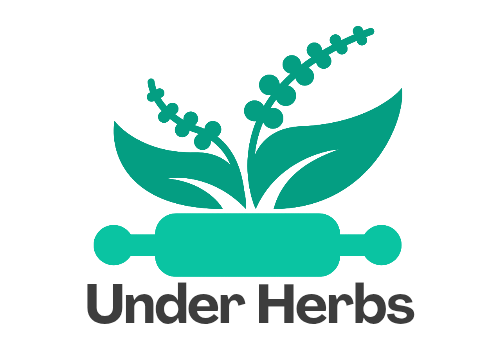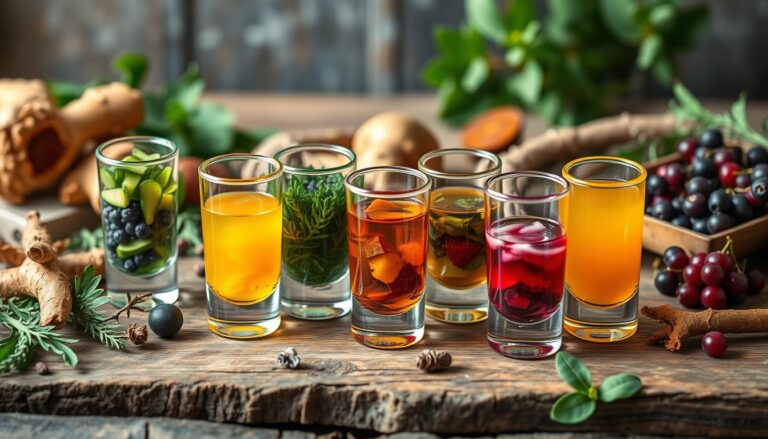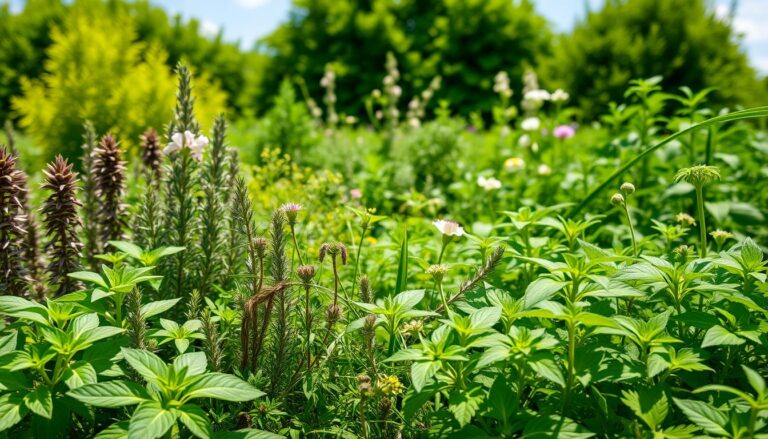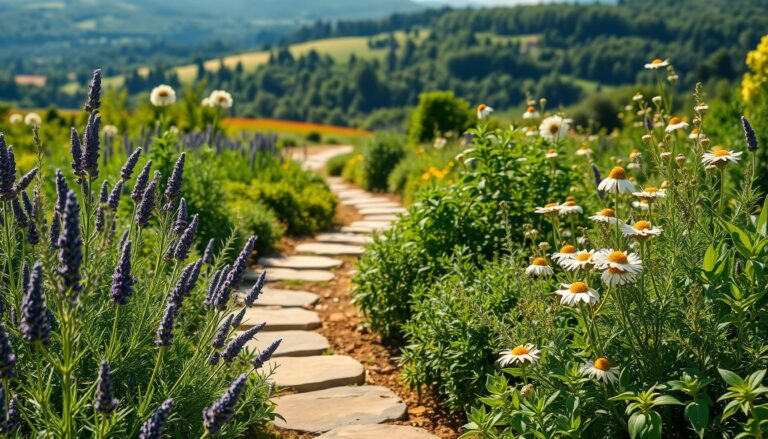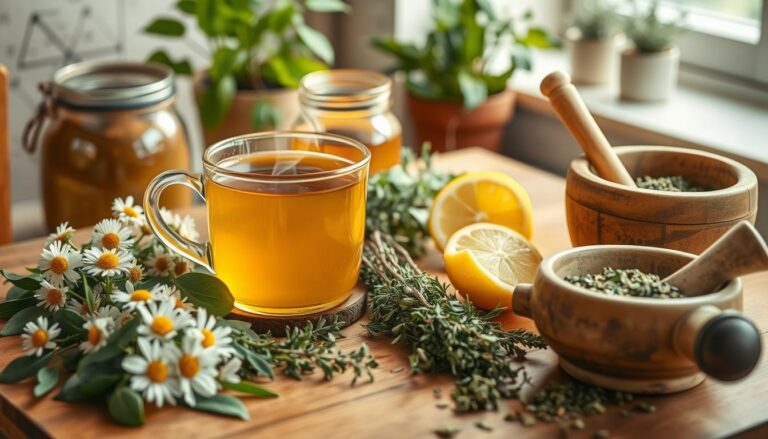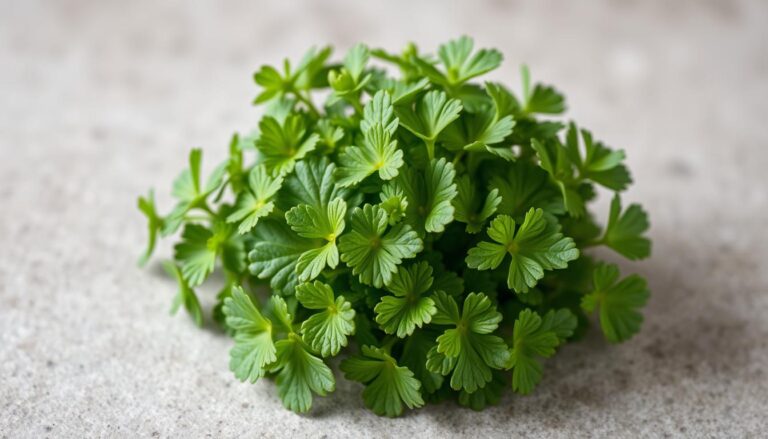Organic Medicinal Herbs For Beginners
Are you curious about using nature to boost your health and wellbeing? Herbal remedies have been around for centuries. They offer a natural choice instead of traditional medicine.
Rosemary Gladstar, known as the godmother of modern herbalism, can guide you. She teaches how to grow, harvest, and use organic medicinal herbs for different needs. This article will introduce you to herbalism, its benefits, and simple ways to use these natural healers.

Learn how to use these plants every day to improve your health. By learning about herbal remedies, you’ll be ready to start a natural health journey.
Key Takeaways
- Learn the basics of growing and harvesting organic medicinal herbs.
- Understand how to prepare herbal remedies for various health benefits.
- Discover the versatility of herbalism in daily health and wellness.
- Explore the natural healing properties of common medicinal herbs.
- Start your journey into herbalism with Rosemary Gladstar’s guidance.
The Healing Power of Nature: Why Grow Your Own Herbs
Growing your own herbs connects you to nature’s healing power. By growing natural healing plants in your garden, you always have fresh, strong herbs for natural medicine.
Health Benefits of Homegrown Remedies
Homegrown remedies are healthier than store-bought ones. They don’t have additives or fillers that can weaken their power. For example, some supplements have fillers to save money but lose potency. But, with homegrown herbs, you can ensure their quality and purity.
The Advantage of Organic Growing Methods
Organic growing boosts the health of your herbs. It avoids harmful chemicals, making your herbs better for you and the planet. This method also helps your garden and the environment, supporting biodiversity and soil health.
Getting Started with Organic Medicinal Herbs
To grow therapeutic herbs, you need the right tools and knowledge. Growing organic medicinal herbs is rewarding. It gives you a natural way to treat health issues.
Basic Gardening Supplies for Herb Growing
First, get basic gardening supplies. You’ll need a garden fork, trowel, watering can, and pots or a garden bed. Good tools help your herbs grow well.
| Gardening Tool | Purpose |
|---|---|
| Garden Fork | Loosening soil and aerating roots |
| Trowel | Planting and transplanting herbs |
| Watering Can | Providing controlled watering |
Understanding Soil Requirements
Knowing soil requirements is key for growing medicinal herbs. Most herbs like well-draining soil with a pH of 6.0 to 7.0. The soil’s makeup affects the herbs’ flavor, aroma, and health benefits.
Planning Your Medicinal Herb Garden
Planning a medicinal herb garden is key to using herbal wellness solutions effectively. A well-planned garden ensures a good harvest and makes the most of herbs’ medicinal benefits.
Choosing the Right Location
When picking a spot for your organic herb garden, think about sunlight and soil quality. Most herbs need 4-6 hours of direct sunlight daily. Also, make sure the area drains well to avoid soggy soil.
Container vs. Ground Planting
Choosing between containers and planting in the ground depends on your space and what you like. Containers are flexible and can be moved, while ground planting lets roots grow deeper. Use containers if you have little space or poor soil.
The choice between containers and ground planting affects your organic herb garden‘s success. By picking the right spot and planting method, you can have a thriving medicinal herb garden.
Lavender: The Versatile Calming Herb
Lavender is a top choice for those who love organic medicinal herbs. Its calming scent and health benefits make it essential. It’s great for teas, tinctures, and even skin treatments.

Growing and Harvesting Lavender
Lavender loves dry soil and full sun. It’s perfect for dry areas. To harvest, wait for the buds to almost open, then cut the stems. Dry them upside down in a cool, dark spot to keep the oils strong.
Medicinal Uses and Preparations
Lavender is famous for its calming effects. It’s great in teas, tinctures, and for baths. For a calming tea, steep dried buds in hot water. For a relaxing bath, add lavender oil. It’s also good in salves for skin issues.
| Preparation | Use | Benefits |
|---|---|---|
| Lavender Tea | Promotes relaxation and improves sleep quality | Calming effects, reduces anxiety |
| Lavender Tincture | Used for stress relief and as a natural remedy for insomnia | Concentrated dose of lavender’s medicinal properties |
| Lavender Salve | Topical application for skin irritations and minor burns | Soothes and heals skin, anti-inflammatory properties |
“Lavender’s calming scent is not just a pleasure to smell; it’s a powerful tool for achieving relaxation and reducing stress.”
Chamomile: Nature’s Gentle Sedative
Chamomile is known for its calming effects. It’s a key herb in natural healing plants. For centuries, it has helped people relax and manage anxiety. It’s a natural choice for those looking for a way to unwind without drugs.
Growing and Harvesting Chamomile
Chamomile is easy to grow and does well in many places. It likes well-drained soil and lots of sunlight. To harvest, just cut off the flower heads when they’re fully open.
This helps the plant grow more flowers. It also makes sure the chamomile is strong for herbal remedies.
Medicinal Uses and Preparations
The flowers of chamomile are where the magic happens. They can be made into tea, tinctures, or creams. Chamomile tea is great for calming anxiety and helping you sleep better.
For skin issues, you can use chamomile creams or salves. Its many uses make it a favorite in natural healing.
Peppermint: The Digestive Aid Powerhouse
Peppermint is famous for its digestive benefits, making it key in holistic herbal medicine. Its scent and taste are not just refreshing. They also have medicinal properties that help with digestion. For those who grow homegrown herbal remedies, peppermint is essential.
Growing and Harvesting Peppermint
Peppermint grows well in moist soil and partial shade. It’s easy to grow in many conditions. But, it can spread a lot, so it’s best in pots to keep it from taking over.
To get its medicinal benefits, harvest peppermint just before it flowers. This is when its oil is most concentrated.
Medicinal Uses and Preparations
Peppermint has many uses, from teas and tinctures to food. To make a digestive tea, steep fresh or dried leaves in hot water. Peppermint tincture, made with alcohol or glycerin, helps with nausea and indigestion.
You can add fresh peppermint leaves to salads or use peppermint extract in baked goods. It adds a refreshing flavor and digestive benefits.
Echinacea: The Immune System Booster
Echinacea is a key part of herbal wellness solutions. It helps prevent illnesses like the common cold and flu. It’s known for boosting the immune system.
Growing and Harvesting Echinacea
Echinacea is easy to grow. It needs well-drained soil and lots of sunlight. Harvest it in the fall when the flowers fade and the roots are mature. The right harvesting techniques are important to keep the herb strong.
Medicinal Uses and Preparations
The roots and flowers of Echinacea are used to make teas, tinctures, and capsules. These are great for boosting the immune system. Adding Echinacea to your wellness routine can help fight off colds and flu.
Calendula: The Skin-Healing Wonder
Calendula is a standout among medicinal herbs for its skin-soothing properties. Known as pot marigold, it’s a key herb in organic gardens. Its vibrant flowers and strong medicinal benefits make it special.

Growing and Harvesting Calendula
Calendula grows well in sunny spots with well-drained soil. It’s an annual that spreads easily, so it’s easy to care for. To harvest, pick the flowers when they’re fully open. Use the petals fresh or dry them for later.
Medicinal Uses and Preparations
Calendula is known for its anti-inflammatory and antimicrobial properties. It’s great for skin problems. Use it in creams, salves, and ointments to heal wounds, soothe burns, and reduce inflammation. You can also infuse it in oil or make a tea for skin use.
Calendula’s benefits also shine in skincare. It helps keep skin healthy and reduces scars and blemishes.
Holy Basil (Tulsi): The Adaptogenic Stress Reliever
Holy Basil is a standout in herbal remedies for fighting stress and boosting well-being. Known as Tulsi, it’s a key herb in holistic medicine for centuries.
Growing and Harvesting Holy Basil
Holy Basil loves well-drained soil and full sun. It’s easy to grow in many conditions. Regular watering and pruning help it grow well. To get more leaves, pinch off flower buds before they bloom.
Medicinal Uses and Preparations
Holy Basil is famous for its adaptogenic properties. It helps the body handle stress. You can find it in teas, tinctures, and capsules. Here’s a table showing how to use it:
| Preparation | Use |
|---|---|
| Tea | Stress relief, antioxidant properties |
| Tincture | Immune system support, adaptogenic benefits |
| Capsules | Convenient daily supplement for overall well-being |
Adding Holy Basil to your daily life can help you deal with stress better. It supports a balanced lifestyle.
Harvesting and Preserving Your Organic Medicinal Herbs
To get the most from your organic medicinal herbs, learning how to harvest and preserve them is key. It’s important to know how to dry and store them right. This keeps their natural healing plants strong.
Best Practices for Harvesting
Harvesting your herbs at the right time is crucial. Most herbs are best picked just before they bloom. This is when their therapeutic properties are strongest. Pick them in the morning, after the dew has gone but before it gets too hot.
Drying Methods
Drying is a key step in keeping your herbs fresh. You can air dry them by tying small bunches and hanging them upside down. Or, use a dehydrator on a low setting to keep their potency. 
Storage Solutions for Maximum Potency
After drying, store your herbs in airtight containers. This keeps them safe from light, moisture, and air. Glass jars with tight lids are perfect. Make sure to label them with the herb’s name and when you stored them.
| Herb | Best Harvest Time | Storage Tips |
|---|---|---|
| Lavender | Just before flowering | Store in dark glass jars |
| Chamomile | When flowers are fully open | Keep in airtight containers |
| Peppermint | Before flowering | Store away from light |
Creating Remedies from Your Herb Garden
With a thriving herb garden, you can make endless homegrown herbal remedies. The journey to wellness starts with knowing how to turn your herbs into effective remedies.
Making Teas and Infusions
Teas and infusions are simple ways to enjoy your herbs. To make a tea, steep fresh or dried herbs in hot water. The amount of herbs and water, and steeping time, depend on the herb and desired strength.
For example, peppermint and chamomile are great for calming teas.
Creating Tinctures and Extracts
Tinctures are concentrated herbal extracts made by soaking herbs in a solvent, like alcohol or glycerin. This method keeps the herb’s medicinal properties. To make a tincture, mix herbs with your chosen solvent in a jar, let it steep, and then strain the liquid.
Crafting Salves and Balms
Salves and balms are topical remedies for skin irritations or injuries. They are made by infusing herbs into oils, then mixing with beeswax to create a solid balm. This process involves careful heating and mixing to get the right consistency.
Safety Precautions for Herbal Preparations
When making herbal wellness solutions, follow safety guidelines. Always know your herbs to avoid mistakes. Also, watch for allergic reactions or interactions with medications. Proper storage and labeling of your remedies are key for safe use.
Conclusion: Your Journey into Herbal Wellness
Growing and using organic medicinal herbs can change your life. It’s a natural way to improve your health. By adding these herbs to your daily routine, you can be more in control of your well-being.
These herbs offer many benefits. They can help with stress, digestion, boost your immune system, and even improve your skin. Learning how to grow, pick, and use them can unlock their full power.
Start your herbal wellness journey with simple herbs like lavender, chamomile, or peppermint. Try making teas, tinctures, and salves to see what works for you. This way, you can find the best way to use them.
Exploring organic medicinal herbs connects you closer to nature. It’s a big step towards better wellness for you.
FAQ
What are the benefits of growing my own organic medicinal herbs?
Growing your own organic medicinal herbs lets you control the quality. You ensure they are free from harmful chemicals. This makes your remedies safer and more effective.
What are some of the best medicinal herbs for beginners to grow?
Beginners can start with lavender, chamomile, peppermint, echinacea, calendula, and holy basil. These herbs are easy to grow and have many uses.
How do I choose the right location for my medicinal herb garden?
Choose a spot with plenty of sunlight and good drainage. Most herbs need 4-6 hours of sunlight daily. They also prefer well-draining soil.
What is the best way to harvest and preserve my medicinal herbs?
Harvest herbs in the morning, after the dew but before it gets hot. You can dry, freeze, or make tinctures and extracts to preserve them.
How do I make remedies from my homegrown medicinal herbs?
You can make teas, tinctures, salves, and balms from your herbs. The method depends on the herb and its use.
Are there any safety precautions I should take when using medicinal herbs?
Yes, always follow the right preparation and dosage. Some herbs can interact with medicines or have side effects. Research the risks before using them.
Can I use medicinal herbs if I have a pre-existing medical condition?
If you have a medical condition, talk to a healthcare professional first. Some herbs may not be safe with your condition or medicines.
How do I store my dried medicinal herbs to maintain their potency?
Store dried herbs in a cool, dark place in airtight containers. Glass jars with tight lids are best for keeping them fresh.
